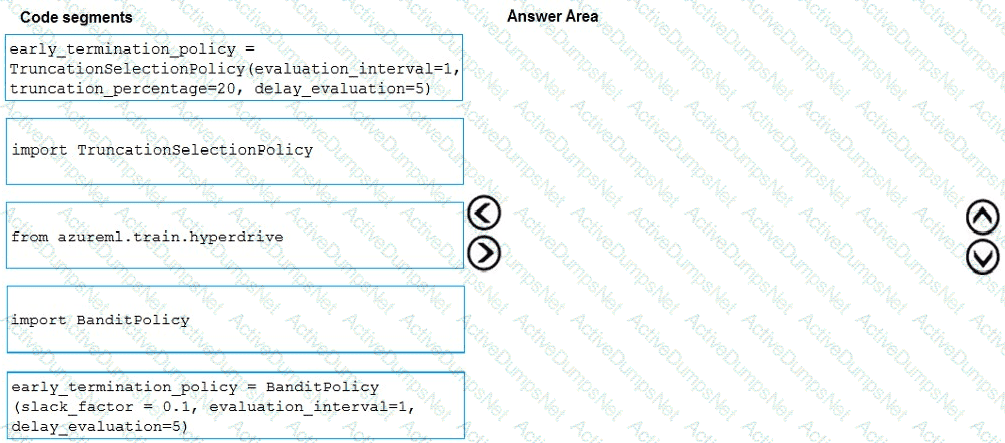Note: This question is part of a series of questions that present the same scenario. Each question in the series contains a unique solution that might meet the stated goals. Some question sets might have more than one correct solution, while others might not have a correct solution.
After you answer a question in this section, you will NOT be able to return to it. As a result, these questions will not appear in the review screen.
You are analyzing a numerical dataset which contains missing values in several columns.
You must clean the missing values using an appropriate operation without affecting the dimensionality of the feature set.
You need to analyze a full dataset to include all values.
Solution: Remove the entire column that contains the missing data point.
Does the solution meet the goal?
You create a batch inference pipeline by using the Azure ML SDK. You run the pipeline by using the following code:
from azureml.pipeline.core import Pipeline
from azureml.core.experiment import Experiment
pipeline = Pipeline(workspace=ws, steps=[parallelrun_step])
pipeline_run = Experiment(ws, 'batch_pipeline').submit(pipeline)
You need to monitor the progress of the pipeline execution.
What are two possible ways to achieve this goal? Each correct answer presents a complete solution.
NOTE: Each correct selection is worth one point.
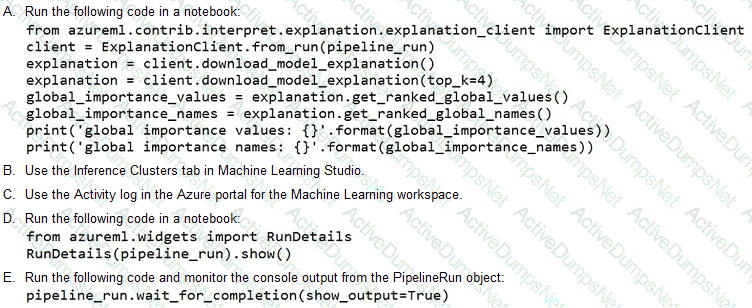
Note: This question is part of a series of questions that present the same scenario. Each question in the series contains a unique solution that might meet the stated goals. Some question sets might have more than one correct solution, while others might not have a correct solution.
After you answer a question in this section, you will NOT be able to return to it. As a result, these questions will not appear in the review screen.
You create an Azure Machine Learning service datastore in a workspace. The datastore contains the following files:
• /data/2018/Q1.csv
• /data/2018/Q2.csv
• /data/2018/Q3.csv
• /data/2018/Q4.csv
• /data/2019/Q1.csv
All files store data in the following format:
id,f1,f2i
1,1.2,0
2,1,1,
1 3,2.1,0
You run the following code:

You need to create a dataset named training_data and load the data from all files into a single data frame by using the following code:

Solution: Run the following code:

Does the solution meet the goal?
Note: This question is part of a series of questions that present the same scenario. Each question in the series contains a unique solution that might meet the stated goals. Some question sets might have more than one correct solution, while others might not have a correct solution.
After you answer a question in this section, you will NOT be able to return to it. As a result, these questions will not appear in the review screen.
You plan to use a Python script to run an Azure Machine Learning experiment. The script creates a reference to the experiment run context, loads data from a file, identifies the set of unique values for the label column, and completes the experiment run:
from azureml.core import Run
import pandas as pd
run = Run.get_context()
data = pd.read_csv('data.csv')
label_vals = data['label'].unique()
# Add code to record metrics here
run.complete()
The experiment must record the unique labels in the data as metrics for the run that can be reviewed later.
You must add code to the script to record the unique label values as run metrics at the point indicated by the comment.
Solution: Replace the comment with the following code:
run.log_table('Label Values', label_vals)
Does the solution meet the goal?
Note: This question is part of a series of questions that present the same scenario. Each question in the series contains a unique solution that might meet the stated goals. Some question sets might have more than one correct solution, while others might not have a correct solution.
After you answer a question in this section, you will NOT be able to return to it. As a result, these questions will not appear in the review screen.
You train and register a machine learning model.
You plan to deploy the model as a real-time web service. Applications must use key-based authentication to use the model.
You need to deploy the web service.
Solution:
Create an AksWebservice instance.
Set the value of the auth_enabled property to False.
Set the value of the token_auth_enabled property to True.
Deploy the model to the service.
Does the solution meet the goal?
You manage an Azure Machine Learning workspace. The development environment for managing the workspace is configured to use Python SDK v2 in Azure Machine Learning Notebooks.
A Synapse Spark Compute is currently attached and uses system-assigned identity.
You need to use Python code to update the Synapse Spark Compute to use a user-assigned identity.
Solution: Create an instance of the MLCIient class.
Does the solution meet the goal?
You have the following Azure subscriptions and Azure Machine Learning service workspaces:

You need to obtain a reference to the mi-protect workspace
Solution: Run the following Python code.

Does the solution meet the goal?
Note: This question is part of a series of questions that present the same scenario. Each question in the series contains a unique solution that might meet the stated goals. Some question sets might have more than one correct solution, while others might not have a correct solution.
After you answer a question in this section, you will NOT be able to return to it as a result, these questions will not appear in the review screen.
You train and register an Azure Machine Learning model.
You plan to deploy the model to an online end point.
You need to ensure that applications will be able to use the authentication method with a non-expiring artifact to access the model.
Solution:
Create a Kubernetes online endpoint and set the value of its auth-mode parameter to amyl Token. Deploy the model to the online endpoint.
Does the solution meet the goal?
Note: This question is part of a series of questions that present the same scenario. Each question in the series contains a unique solution that might meet the stated goals. Some question sets might have more than one correct solution, while others might not have a correct solution.
After you answer a question in this section, you will NOT be able to return to it. As a result, these questions will not appear in the review screen.
You are using Azure Machine Learning to run an experiment that trains a classification model.
You want to use Hyperdrive to find parameters that optimize the AUC metric for the model. You configure a HyperDriveConfig for the experiment by running the following code:

You plan to use this configuration to run a script that trains a random forest model and then tests it with validation data. The label values for the validation data are stored in a variable named y_test variable, and the predicted probabilities from the model are stored in a variable named y_predicted.
Solution: Run the following code:
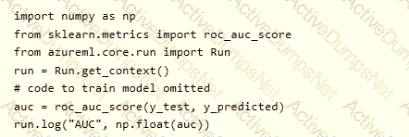
Does the solution meet the goal?
You are using a decision tree algorithm. You have trained a model that generalizes well at a tree depth equal to 10.
You need to select the bias and variance properties of the model with varying tree depth values.
Which properties should you select for each tree depth? To answer, select the appropriate options in the answer area.

You deploy a model in Azure Container Instance.
You must use the Azure Machine Learning SDK to call the model API.
You need to invoke the deployed model using native SDK classes and methods.
How should you complete the command? To answer, select the appropriate options in the answer areas.
NOTE: Each correct selection is worth one point.
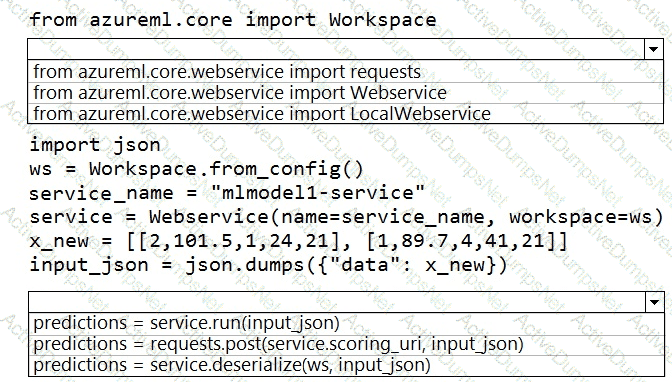
You have an Azure Machine Learning workspace and a data source file ./data/cc_data.csv in the local storage.
You plan to use Azure Machine Learning Python SDK v2 to store the content of the cc.data.csv file in a data asset named cc_data_asset in the workspace.
You write code to connect to the workspace and import all required libraries.
You need to complete the remaining code to ensure it will result in the cc_data_asset that contains the data from cc_data.csv.
How should you complete the code? To answer, select the appropriate options in the answer area.
NOTE: Each correct selection is worth one point.

You ate designing a training job in an Azure Machine Learning workspace by using Automated ML During training, the compute resource must scale up to handle larger datasets. You need to select the compute resource that has a multi-node cluster that automatically scales Which Azure Machine Learning compute target should you use?
You train classification and regression models by using automated machine learning.
You must evaluate automated machine learning experiment results. The results include how a classification model is making systematic errors in its predictions and the relationship between the target feature and the regression model's predictions. You must use charts generated by automated machine learning.
You need to choose a chart type for each model type.
Which chart types should you use? To answer, select the appropriate options in the answer area.
NOTE: Each correct selection is worth one point.

You have a dataset created for multiclass classification tasks that contains a normalized numerical feature set with 10,000 data points and 150 features.
You use 75 percent of the data points for training and 25 percent for testing. You are using the scikit-learn machine learning library in Python. You use X to denote the feature set and Y to denote class labels.
You create the following Python data frames:
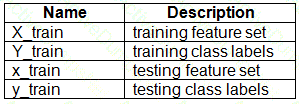
You need to apply the Principal Component Analysis (PCA) method to reduce the dimensionality of the feature set to 10 features in both training and testing sets.
How should you complete the code segment? To answer, select the appropriate options in the answer area.
NOTE: Each correct selection is worth one point.

You are the owner of an Azure Machine Learning workspace.
You must prevent the creation or deletion of compute resources by using a custom role. You must allow all other operations inside the workspace.
You need to configure the custom role.
How should you complete the configuration? To answer, select the appropriate options in the answer area.
NOTE: Each correct selection is worth one point.

You are performing sentiment analysis using a CSV file that includes 12,000 customer reviews written in a short sentence format. You add the CSV file to Azure Machine Learning Studio and configure it as the starting point dataset of an experiment. You add the Extract N-Gram Features from Text module to the experiment to extract key phrases from the customer review column in the dataset.
You must create a new n-gram dictionary from the customer review text and set the maximum n-gram size to trigrams.
What should you select? To answer, select the appropriate options in the answer area.
NOTE: Each correct selection is worth one point.
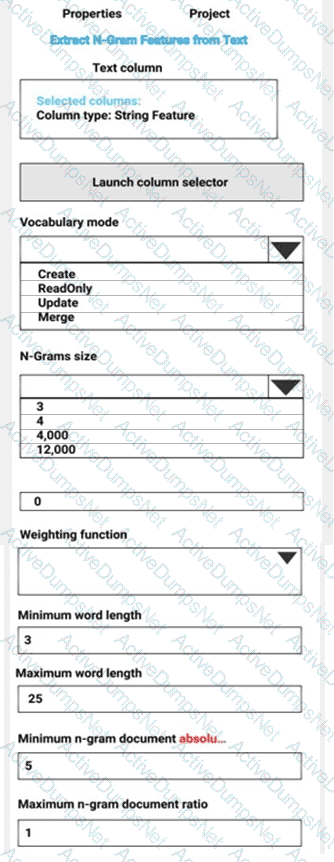
You are with a time series dataset in Azure Machine Learning Studio.
You need to split your dataset into training and testing subsets by using the Split Data module.
Which splitting mode should you use?
You have an Azure Machine Learning workspace. You build a deep learning model.
You need to publish a GPU-enabled model as a web service.
Which two compute targets can you use? Each correct answer presents a complete solution.
NOTE: Each correct selection is worth one point.
: 214 HOTSPOT
You create a script for training a machine learning model in Azure Machine Learning service.
You create an estimator by running the following code:

For each of the following statements, select Yes if the statement is true. Otherwise, select No.
NOTE: Each correct selection is worth one point.
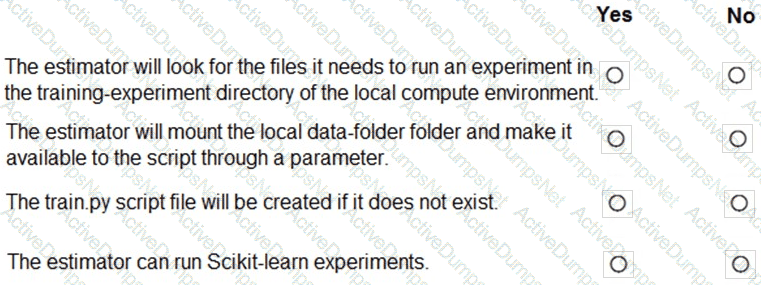
You manage an Azure Machine Learning workspace by using the Python SDK v2.
You must create a compute cluster in the workspace. The compute cluster must run workloads and properly handle interruptions. You start by calculating the maximum amount of compute resources required by the workloads and size the cluster to match the calculations.
The cluster definition includes the following properties and values:
• name="mlcluster1’’
• size="STANDARD.DS3.v2"
• min_instances=1
• maxjnstances=4
• tier="dedicated"
The cost of the compute resources must be minimized when a workload is active Of idle. Cluster property changes must not affect the maximum amount of compute resources available to the workloads run on the cluster.
You need to modify the cluster properties to minimize the cost of compute resources.
Which properties should you modify? To answer, select the appropriate options in the answer area.
NOTE: Each correct selection is worth one point.

You have an Azure Machine Learning workspace that contains a CPU-based compute cluster and an Azure Kubernetes Services (AKS) inference cluster. You create a tabular dataset containing data that you plan to use to create a classification model.
You need to use the Azure Machine Learning designer to create a web service through which client applications can consume the classification model by submitting new data and getting an immediate prediction as a response.
Which three actions should you perform in sequence? To answer, move the appropriate actions from the list of actions to the answer area and arrange them in the correct order.
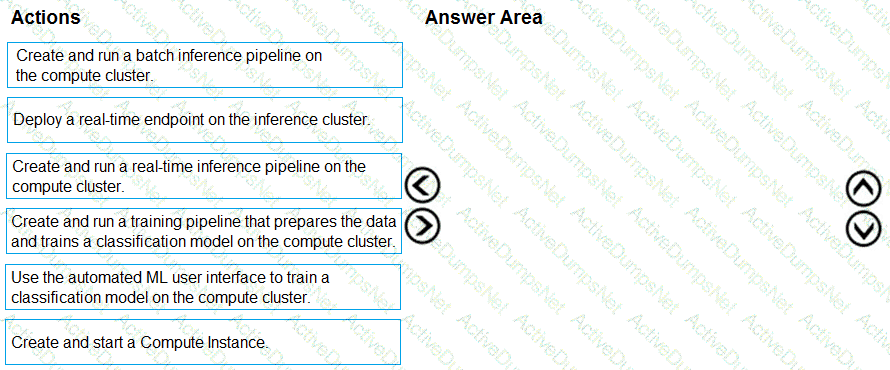
You have an Azure Al Foundry project named Projects
You are developing a web classification Prompt flow named Flow1 in Project 1. The current input of Flow1 is defined as the following:

You plan to add a large language model (LLM) node named Nodel to Flowl. Nodel will use an input named url of type string to classify the url provided as Flowl input. In Nodel. you will add Jinja code to reference the value of its url input. ^
You need to ensure Node1 will classify the provided url values as the Flowl input.
How should you configure Nodel? To answer, move the appropriate values to the correct Nodel configurations. You may use each value once, more than once, or not at all. You may need to move the split bar between panes or scroll to view content.

You create a multi-class image classification deep learning model that uses the PyTorch deep learning
framework.
You must configure Azure Machine Learning Hyperdrive to optimize the hyperparameters for the classification model.
You need to define a primary metric to determine the hyperparameter values that result in the model with the best accuracy score.
Which three actions must you perform? Each correct answer presents part of the solution.
NOTE: Each correct selection is worth one point.
Note: This question is part of a series of questions that present the same scenario. Each question in the series contains a unique solution that might meet the stated goals. Some question sets might have more than one correct solution, while others might not have a correct solution.
After you answer a question in this section, you will NOT be able to return to it. As a result, these questions will not appear in the review screen.
You train and register an Azure Machine Learning model.
You plan to deploy the model to an online endpoint.
You need to ensure that applications will be able to use the authentication method with a non-expiring artifact to access the model.
Solution:
Create a managed online endpoint and set the value of its auto_mode parameter to key. Deploy the model to the inline endpoint.
Does the solution meet the goal?
You manage an Azure Al Foundry project.
You plan to fine-tune a base model by using pre-uploaded training and validation data. You must specify a hyperparameter to ensure the job is reproducible.
You need to submit the fine-tuning training job.
How should you complete the Python code segment? To answer, select the appropriate options in the answer area.
NOTE: Each correct selection is worth one point.
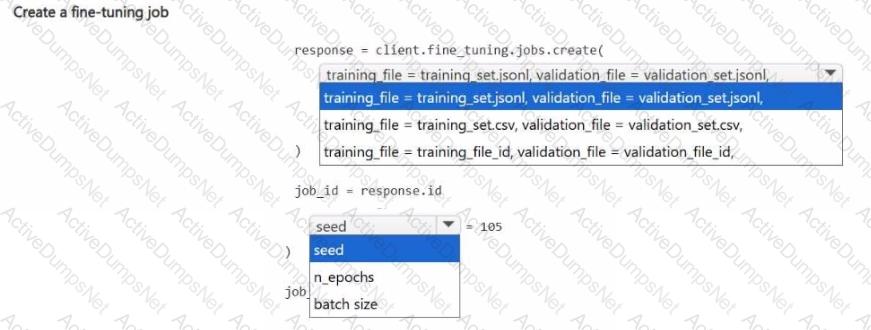
You train a model by using Azure Machine Learning. You use Azure Blob Storage to store production data.
The model must be re-trained when new data is uploaded to Azure Blob Storage. You need to minimize development and coding.
You need to configure Azure services to develop a re-training solution.
Which Azure services should you use? To answer, select the appropriate options in the answer area.
NOTE: Each correct selection is worth one point.

The finance team asks you to train a model using data in an Azure Storage blob container named finance-data.
You need to register the container as a datastore in an Azure Machine Learning workspace and ensure that an error will be raised if the container does not exist.
How should you complete the code? To answer, select the appropriate options in the answer area.
NOTE: Each correct selection is worth one point.
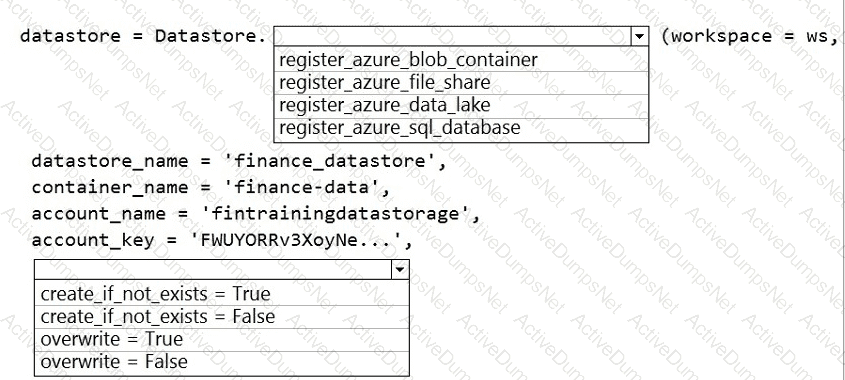
You are using Azure Machine Learning to monitor a trained and deployed model. You implement Event Grid to respond to Azure Machine Learning events.
Model performance has degraded due to model input data changes.
You need to trigger a remediation ML pipeline based on an Azure Machine Learning event.
Which event should you use?
You have a Python script that executes a pipeline. The script includes the following code:
from azureml.core import Experiment
pipeline_run = Experiment(ws, 'pipeline_test').submit(pipeline)
You want to test the pipeline before deploying the script.
You need to display the pipeline run details written to the STDOUT output when the pipeline completes.
Which code segment should you add to the test script?
You manage an Azure Machine Learning workspace named projl
You plan to use assets defined in projl to create a pipeline in the Machine Learning studio designer
You need to set the Registry name filter to display only the list of assets defined in projl.
What should you set the Registry name filter to?
You create a new Azure Machine Learning workspace with a compute cluster.
You need to create the compute cluster asynchronously by using the Azure Machine Learning Python SDK v2.
How should you complete the code segment? To answer, select the appropriate options in the answer area.
NOTE: Each correct selection is worth one point

You manage an Azure Machine Learning workspace. You use Azure Machine Learning Python SDK v2 to configure a trigger to schedule a pipeline job. You need to create a time-based schedule with recurrence pattern.
Which two properties must you use to successfully configure the trigger? Each correct answer presents part of the solution. NOTE: Each correct selection is worth one point.
Note: This question is part of a series of questions that present the same scenario. Each question in the series contains a unique solution that might meet the stated goals. Some question sets might have more than one correct solution, while others might not have a correct solution.
After you answer a question in this section, you will NOT be able to return to it. As a result, these questions will not appear in the review screen.
You are a data scientist using Azure Machine Learning Studio.
You need to normalize values to produce an output column into bins to predict a target column.
Solution: Apply an Equal Width with Custom Start and Stop binning mode.
Does the solution meet the goal?

For each of the following statements, select Yes if the statement is true. Otherwise, select No. NOTE: Each correct selection is worth one point.

You manage an Azure Machine Learning workspace. The development environment for managing the workspace is configured to use Python SDK v2 in Azure Machine Learning Notebooks
A Synapse Spark Compute is currently attached and uses system-assigned identity
You need to use Python code to update the Synapse Spark Compute to use a user-assigned identity.
Solution: Create an instance of the MICIient class.
Does the solution meet the goal?
You have an Azure Machine Learning workspace named Workspace 1 Workspace! has a registered Mlflow model named model 1 with PyFunc flavor
You plan to deploy model1 to an online endpoint named endpointl without egress connectivity by using Azure Machine learning Python SDK vl
You have the following code:

You need to add a parameter to the ManagedOnllneDeployment object to ensure the model deploys successfully
Solution: Add the with_package parameter.
Does the solution meet the goal?
You use a training pipeline in the Azure Machine Learning designer. You register a datastore named ds1. The datastore contains multiple training data files. You use the Import Data module with the configured datastore.
You need to retrain a model on a different set of data files.
Which four actions should you perform in sequence? To answer, move the appropriate actions from the list of actions to the answer area and arrange them in the correct order.

You run Azure Machine Learning training experiments. The training scripts directory contains 100 files that includes a file named. amlignore. The directory also contains subdirectories named. /outputs and./logs.
There are 20 files in the training scripts directory that must be excluded from the snapshot to the compute targets. You create a file named. gift ignore in the root of the directory. You add the names of the 20 files to the. gift ignore file. These 20 files continue to be copied to the compute targets.
You need to exclude the 20 files. What should you do?
You use the following Python code in a notebook to deploy a model as a web service:

The deployment fails.
You need to use the Python SDK in the notebook to determine the events that occurred during service deployment an initialization.
Which code segment should you use?
Note: This question is part of a series of questions that present the same scenario. Each question in the series contains a unique solution that might meet the stated goals. Some question sets might have more than one correct solution, while others might not have a correct solution.
After you answer a question in this section, you will NOT be able to return to it. As a result, these
questions will not appear in the review screen.
You are creating a model to predict the price of a student’s artwork depending on the following variables: the student’s length of education, degree type, and art form.
You start by creating a linear regression model.
You need to evaluate the linear regression model.
Solution: Use the following metrics: Relative Squared Error, Coefficient of Determination, Accuracy, Precision, Recall, F1 score, and AUC.
Does the solution meet the goal?
You manage an Azure Al Foundry project
You plan to create a search index by using the Azure Al Foundry SDK.
You need to configure the Content field as a prioritized field for semantic ranking The field is already set to be searchable.
How should you complete the item code segment? To answer, select the appropriate options in the answer area.
NOTE: Each correct selection is worth one point.
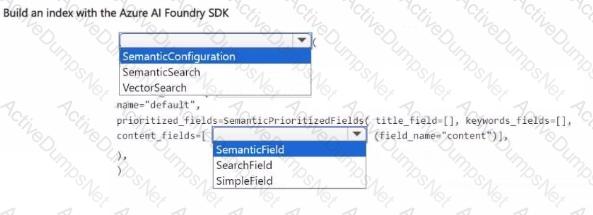
You manage an Azure Machine Learning workspace. The development environment tor managing the workspace is configured to use Python SDK v2 in Azure Machine Learning Notebooks A Synapse Spark Compute is currently attached and uses system-assigned identity You need to use Python code to update the Synapse Spark Compute 10 use a user-assigned identity.
Solution: Configure the IdentityConfiguration class with the appropriate identity type.
Does the solution meet the goal?
You are retrieving data from a large datastore by using Azure Machine Learning Studio.
You must create a subset of the data for testing purposes using a random sampling seed based on the system clock.
You add the Partition and Sample module to your experiment.
You need to select the properties for the module.
Which values should you select? To answer, select the appropriate options in the answer area.
NOTE: Each correct selection is worth one point.
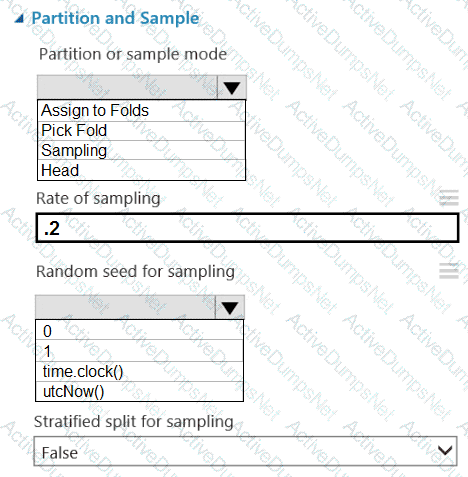
You are creating a machine learning model.
You need to identify outliers in the data.
Which two visualizations can you use? Each correct answer presents a complete solution.
NOTE: Each correct selection is worth one point.
NOTE: Each correct selection is worth one point.
You manage an Azure Machine Learning workspace. You create an experiment named experiment1 by using the Azure Machine Learning Python SDK v2 and MLflow.

For each of the following statements, select Yes if the statement is true. Otherwise, select No.

You plan to use the Hyperdrive feature of Azure Machine Learning to determine the optimal hyperparameter values when training a model.
You must use Hyperdrive to try combinations of the following hyperparameter values. You must not apply an early termination policy.
learning_rate: any value between 0.001 and 0.1
• batch_size: 16, 32, or 64
You need to configure the sampling method for the Hyperdrive experiment
Which two sampling methods can you use? Each correct answer is a complete solution.
NOTE: Each correct selection is worth one point.
You have a dataset that is stored m an Azure Machine Learning workspace.
You must perform a data analysis for differentiate privacy by using the SmartNoise SDK.
You need to measure the distribution of reports for repeated queries to ensure that they are balanced
Which type of test should you perform?
Note: This question is part of a series of questions that present the same scenario. Each question in the series contains a unique solution that might meet the stated goals. Some question sets might have more than one correct solution, while others might not have a correct solution.
After you answer a question in this section, you will NOT be able to return to it. As a result, these questions will not appear in the review screen.
You are a data scientist using Azure Machine Learning Studio.
You need to normalize values to produce an output column into bins to predict a target column.
Solution: Apply a Quantiles binning mode with a PQuantile normalization.
Does the solution meet the goal?
You are developing deep learning models to analyze semi-structured, unstructured, and structured data types.
You have the following data available for model building:
Video recordings of sporting events
Transcripts of radio commentary about events
Logs from related social media feeds captured during sporting events
You need to select an environment for creating the model.
Which environment should you use?
You develop a Prompt flow in an Azure Al Foundry project.
You plan to use variants and invoke a custom API in the flow.
You need to add tools to the flow that will implement the planned functionality. Your solution must minimize development efforts.
Which tools should you use? To answer, move the appropriate tools to the correct functionalities. You may use each tool once, more than once, or not at all. You may need to move the split bar between panes or scroll to view content.
NOTE: Each correct selection is worth one point.

You need to implement a feature engineering strategy for the crowd sentiment local models.
What should you do?
You need to implement a new cost factor scenario for the ad response models as illustrated in the
performance curve exhibit.
Which technique should you use?
You need to resolve the local machine learning pipeline performance issue. What should you do?
You need to define an evaluation strategy for the crowd sentiment models.
Which three actions should you perform in sequence? To answer, move the appropriate actions from the list of actions to the answer area and arrange them in the correct order.
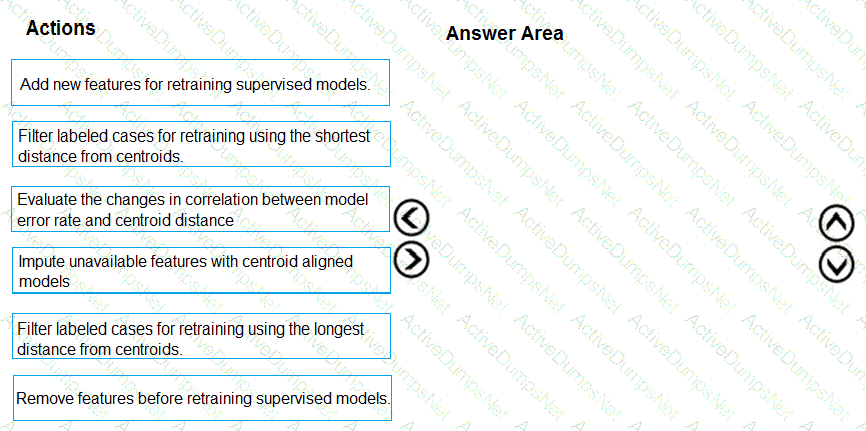
You need to modify the inputs for the global penalty event model to address the bias and variance issue.
Which three actions should you perform in sequence? To answer, move the appropriate actions from the list of actions to the answer area and arrange them in the correct order.

You need to implement a scaling strategy for the local penalty detection data.
Which normalization type should you use?
You need to define a process for penalty event detection.
Which three actions should you perform in sequence? To answer, move the appropriate actions from the list of actions to the answer area and arrange them in the correct order.
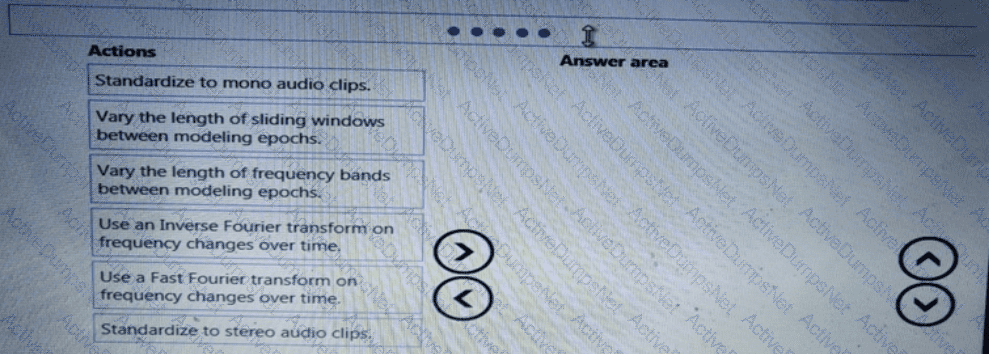
You need to define a modeling strategy for ad response.
Which three actions should you perform in sequence? To answer, move the appropriate actions from the list of actions to the answer area and arrange them in the correct order.

You need to define a process for penalty event detection.
Which three actions should you perform in sequence? To answer, move the appropriate actions from the list of actions to the answer area and arrange them in the correct order.
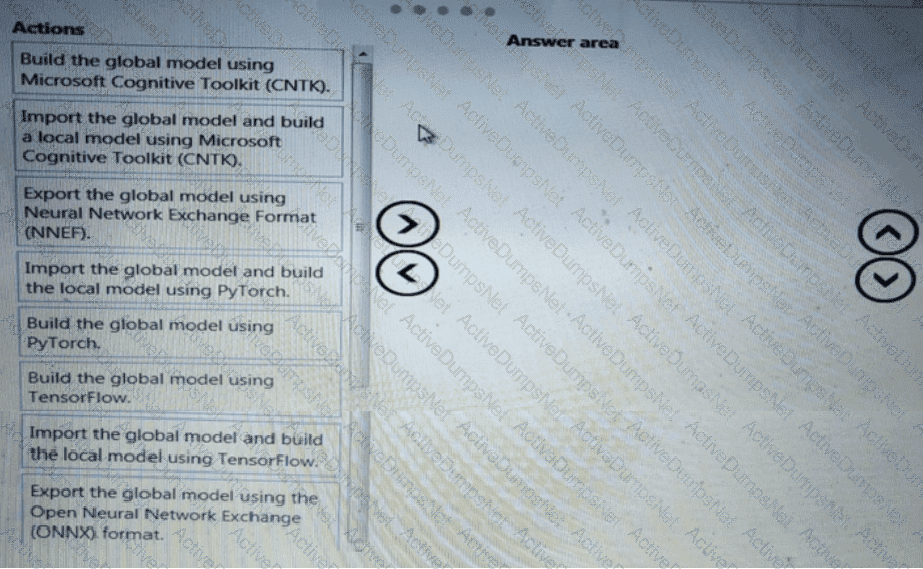
You need to define an evaluation strategy for the crowd sentiment models.
Which three actions should you perform in sequence? To answer, move the appropriate actions from the list of actions to the answer area and arrange them in the correct order.
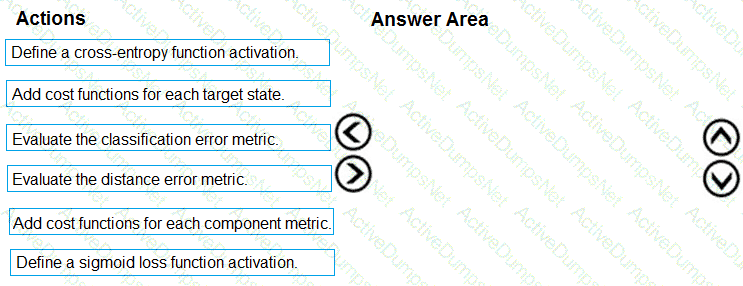
You need to build a feature extraction strategy for the local models.
How should you complete the code segment? To answer, select the appropriate options in the answer area.
NOTE: Each correct selection is worth one point.

You need to implement a model development strategy to determine a user’s tendency to respond to an ad.
Which technique should you use?
You need to select an environment that will meet the business and data requirements.
Which environment should you use?
You need to use the Python language to build a sampling strategy for the global penalty detection models.
How should you complete the code segment? To answer, select the appropriate options in the answer area.
NOTE: Each correct selection is worth one point.
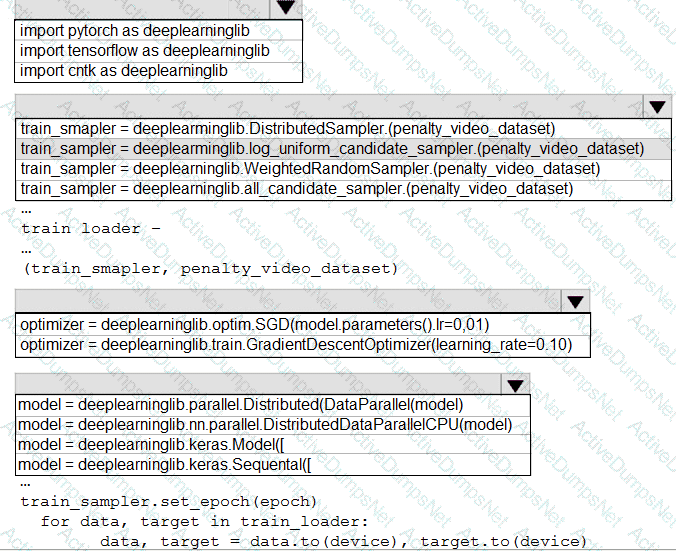
You need to identify the methods for dividing the data according, to the testing requirements.
Which properties should you select? To answer, select the appropriate option-, m the answer area. NOTE: Each correct selection is worth one point.

You need to produce a visualization for the diagnostic test evaluation according to the data visualization requirements.
Which three modules should you recommend be used in sequence? To answer, move the appropriate modules from the list of modules to the answer area and arrange them in the correct order.

You need to replace the missing data in the AccessibilityToHighway columns.
How should you configure the Clean Missing Data module? To answer, select the appropriate options in the answer area.
NOTE: Each correct selection is worth one point.
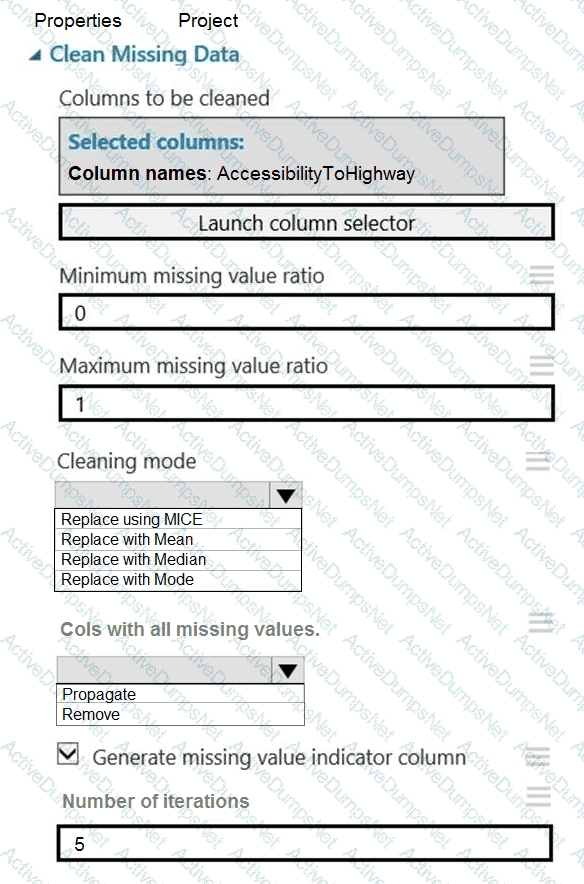
You need to select a feature extraction method.
Which method should you use?
You need to set up the Permutation Feature Importance module according to the model training requirements.
Which properties should you select? To answer, select the appropriate options in the answer area.
NOTE: Each correct selection is worth one point.
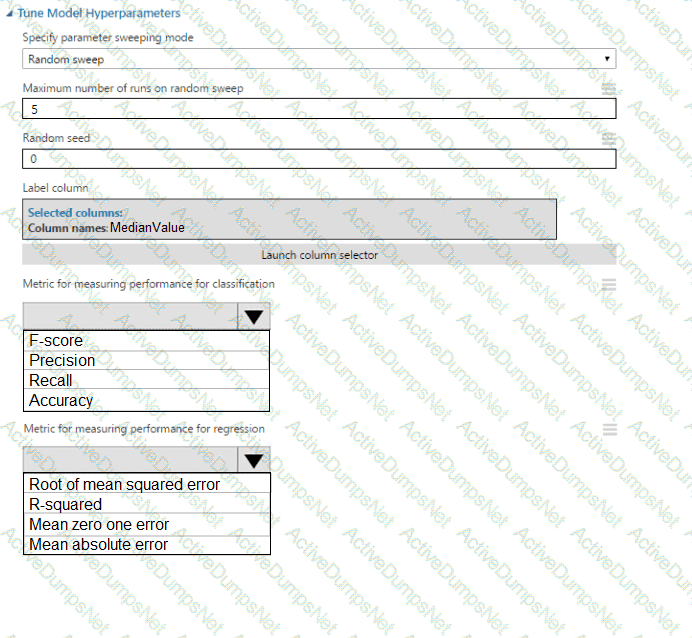
You need to configure the Edit Metadata module so that the structure of the datasets match.
Which configuration options should you select? To answer, select the appropriate options in the answer area.
NOTE: Each correct selection is worth one point.
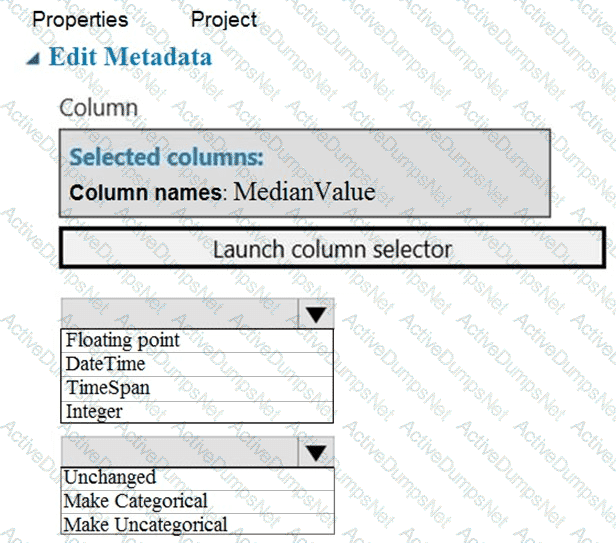
You need to identify the methods for dividing the data according to the testing requirements.
Which properties should you select? To answer, select the appropriate options in the answer area.
NOTE: Each correct selection is worth one point.
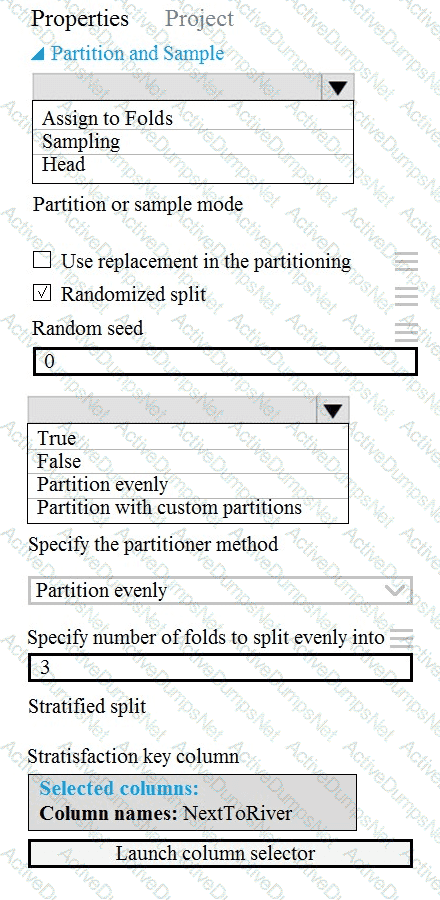
You need to select a feature extraction method.
Which method should you use?
You need to correct the model fit issue.
Which three actions should you perform in sequence? To answer, move the appropriate actions from the list of actions to the answer area and arrange them in the correct order.

You need to configure the Permutation Feature Importance module for the model training requirements.
What should you do? To answer, select the appropriate options in the dialog box in the answer area.
NOTE: Each correct selection is worth one point.

You need to configure the Feature Based Feature Selection module based on the experiment requirements and datasets.
How should you configure the module properties? To answer, select the appropriate options in the dialog box in the answer area.
NOTE: Each correct selection is worth one point.
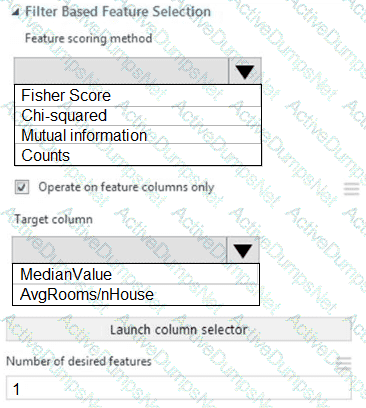
You need to visually identify whether outliers exist in the Age column and quantify the outliers before the outliers are removed.
Which three Azure Machine Learning Studio modules should you use in sequence? To answer, move the appropriate modules from the list of modules to the answer area and arrange them in the correct order.
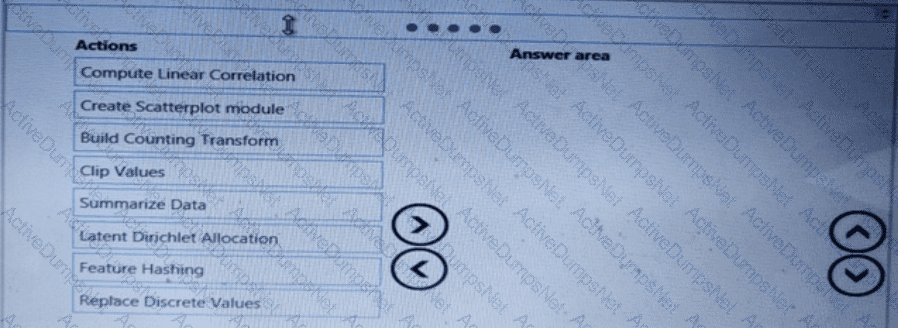
You need to implement early stopping criteria as suited in the model training requirements.
Which three code segments should you use to develop the solution? To answer, move the appropriate code segments from the list of code segments to the answer area and arrange them in the correct order.
NOTE: More than one order of answer choices is correct. You will receive credit for any of the correct orders you select.
